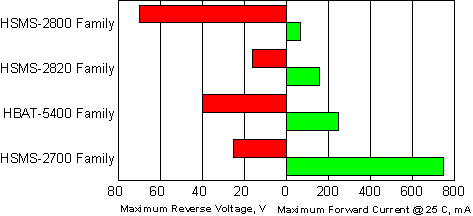|
|
|
Schottky Diode Application Selection Guide
SMT Clamping, Clipping and Analog Switching Diodes
|
|

Features:
fast response time
appropriate threshold (clipping level)
low series resistance for high current handling
low capacitance
Key Parameters:
- Speed :
- 10s of psec ( vs. 10's of nsec for Au doped PN) for all Agilent Technologies Schottky diodes
- If max (maximum forward current) :
- 750 mA for HSMS-270x
- 250 mA for HBAT-540x
- 160 mA for HSMS-282x
- 70 mA for HSMS-280x
[values assume use of thermally superior SOT-323 package]
- Rs (series resistance) :
- 0.65
 for HSMS-270x for HSMS-270x
- 2.4
 for HBAT-540x for HBAT-540x
- 7
 for HSMS-282x for HSMS-282x
- 30
 for HSMS-280x for HSMS-280x
- Barrier height :
- 0.34 - 0.41 V for standard Schottky diodes
- 0.19 V for zero bias Schottky diodes
- 0.7 V for GaAs Schottky diodes
- Breakdown voltage :
- 15 V for HSMS-270x
- 16 V for HSMS-282x
- 30 V for HBAT-540x
- 70 V for HSMS-280x
- Typical Capacitance :
- 1.0 pF for HSMS-282x
- 2.0 pF for HSMS-280x
- 3.0 pF for HBAT-540x
- 6.7 pF for HSMS-270x
Markets:
Computers (spike elimination, reduction of "ringing", elimination of reflections of high speed data signals, digital circuit switch)
Analog and digital designs requiring circuit protection or waveform cleanup with high switching speed.
Clamping Diode Terms
Speed
- What:
- how fast the diode can respond to a signal (alternately, how fast a signal can be clipped or clamped).
- Goodness:
- faster is better.
Forward Current of a Schottky Diode (If)
- What:
- The maximum forward current of a Schottky diode is measure of how much current the diode can sink. The forward current If is inversely proportional to Rs, Vf, and
 jc, and can be calculated from: jc, and can be calculated from:
If = [Tj - Ta]/[ jc Rs] jc Rs]
or
If = [Tj - Ta]/[ jc Vf] jc Vf]
Plots of If vs. Vf, and of Tj and Pdiss vs. If can be calculated using the Mathcad worksheet SCHOTTKY.MCD
- Since If is inversely proportional to
 jc, it is very importat that a thermally efficient package be used. All four clamping diode families are available both SOT-23 and SOT-323 (SC-70) packages. The following table shows why the SOT-323 package is preferred for clamping applications. jc, it is very importat that a thermally efficient package be used. All four clamping diode families are available both SOT-23 and SOT-323 (SC-70) packages. The following table shows why the SOT-323 package is preferred for clamping applications.
| package |
lead material |
thermal resistance |
| SOT-23 |
iron alloy |
460 C/W |
| SOT-323 |
copper |
100 C/W |
- Goodness:
- higher is better.
Series Resistance of a Schottky Diode (Rs)
- What:
- Schottky diode resistance may be expressed as a series resistance Rs or as a dynamic resistance RD. These two terms are related by the equation RD = Rs + Rj, where Rj is the resistance of the junction. Junction resistance of a diode with DC bias is quite accurately calculated by Rj = 26/Ib where Ib is the bias current in milliamperes. Either resistance is a measure of the "loss" in the diode.
- Goodness:
- lower is better.
Barrier height
- What:
- The term "Barrier height" is related to the voltage required for a given current in a Schottky barrier diode. Low voltage corresponds to low barrier height. Barrier height also sets Vf, the voltage at which the diode starts to clip.
- Goodness:
- depends on the application - the Vf must match the desired clipping voltage.
Breakdown voltage (Vbr)
- What:
- the voltage a Schottky barrier diode can tolerate before being damaged.
- Goodness:
- In clamping applications, breakdown voltage only matters if an anti-parallel pair isn't used (most people use a pair), then a higher breakdown voltage is (usually) better, at the cost of increased Rs (current carrying capacity).
|
|





